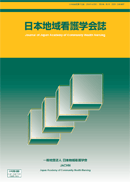Volume 2, Issue 1
Displaying 1-12 of 12 articles from this issue
- |<
- <
- 1
- >
- >|
-
Article type: Article
2000Volume 2Issue 1 Pages 11-16
Published: March 15, 2000
Released on J-STAGE: April 20, 2017
Download PDF (1920K) -
Article type: Article
2000Volume 2Issue 1 Pages 17-24
Published: March 15, 2000
Released on J-STAGE: April 20, 2017
Download PDF (2152K) -
Article type: Article
2000Volume 2Issue 1 Pages 25-30
Published: March 15, 2000
Released on J-STAGE: April 20, 2017
Download PDF (1676K) -
Article type: Article
2000Volume 2Issue 1 Pages 31-35
Published: March 15, 2000
Released on J-STAGE: April 20, 2017
Download PDF (1316K) -
Article type: Article
2000Volume 2Issue 1 Pages 36-43
Published: March 15, 2000
Released on J-STAGE: April 20, 2017
Download PDF (2428K) -
Article type: Article
2000Volume 2Issue 1 Pages 44-50
Published: March 15, 2000
Released on J-STAGE: April 20, 2017
Download PDF (1445K) -
Article type: Article
2000Volume 2Issue 1 Pages 51-60
Published: March 15, 2000
Released on J-STAGE: April 20, 2017
Download PDF (2645K) -
Article type: Article
2000Volume 2Issue 1 Pages 61-68
Published: March 15, 2000
Released on J-STAGE: April 20, 2017
Download PDF (2176K) -
Article type: Article
2000Volume 2Issue 1 Pages 69-75
Published: March 15, 2000
Released on J-STAGE: April 20, 2017
Download PDF (1947K) -
Article type: Article
2000Volume 2Issue 1 Pages 76-79
Published: March 15, 2000
Released on J-STAGE: April 20, 2017
Download PDF (979K) -
Article type: Article
2000Volume 2Issue 1 Pages 80-86
Published: March 15, 2000
Released on J-STAGE: April 20, 2017
Download PDF (1812K) -
Article type: Article
2000Volume 2Issue 1 Pages 87-92
Published: March 15, 2000
Released on J-STAGE: April 20, 2017
Download PDF (1678K)
- |<
- <
- 1
- >
- >|
